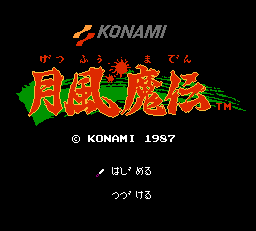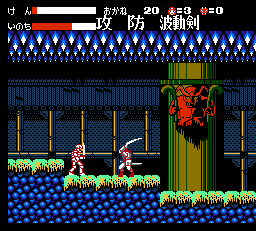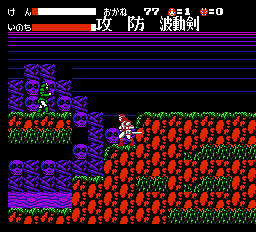Main
What's
New
Import Stores
Import Reviews
Import Cover Archive
Special Features
Games
The Top
100
Video Game Fiction
Wanted!
Acknowledgements
Forum
Links
Import Stores
Import Reviews
Import Cover Archive
Special Features
Games
The Top 100
Video Game Fiction
Wanted!
Acknowledgements
Forum
Links



Getsu Fuu Ma Den is THE only game which I feel shouldn’t exist in the 80s because it was beyond its time and surpassed all mediocre games of its era. In the time when playing Mario Brothers was still the hype and other brainless games saturate the game market, Getsu Fuu Ma Den shone like a gem in the gaming world. Its quality was so high that I find it hard to believe it existed when everybody just started to know who 'Mario' was. Personally, I think Getsu Fuu Ma Den is the very FIRST high quality Action-RPG that ever existed on our planet.
Getsu Fuu Ma Den (which, if you were wondering, means "Moon Wind Devil Story" according to Japanese reader Hotaka - ed) tells of our hero Fuuma (the Samurai) who ventured forth in a quest to avenge the deaths of his three elder brothers who was killed by the monsters on Devil's Islands. Before their valiant deaths, the brothers entered the islands wielding the secret family heirloom – three legendary ‘Hadokens’ (Wave Swords) – which they used to destroy the evil creatures there. But since they lost the battle, the three swords were now lost. Being the last of the four brothers, the hero now seeks to recover the three swords and to exact revenge on those who cause their deaths. The true power of the Wave Swords can only be revealed when someone combines the swords together, which the True Hadoken can be formed. The True Hadoken is the only weapon capable of destroying the Demon King, which controls the monsters and is the source of all evil on the islands.
Viewing from a top-down perspective, Fuuma starts his adventure in a world consisted of three large islands that he had to explore from end to end. Each area on the World Map where evil minions reside is marked by a Japanese style ‘gateway’ that our hero had to conquer in order to progress further into its depths. Entering the gateway would spiral Fuuma into a 2-D world where the traditional ‘platform’ style of play applies. In this format, Fuuma had to run, jump and clear away obstacles before exiting it at the other end. And who can forget those elegantly designed ‘platforms’ each gateway holds, and the pounding music that accompanies Fuuma as he slashes all evil minions that block his path! It's all action-packed excitement to the very end!
Getsu Fuu Ma Den has many characteristics of an action-RPG. It has an element of ‘experience’ in the form of a 'Sword' bar on the screen that you can automatically accumulate according to the number of enemies you killed. As the 'Sword' experience fills up, the more powerful your blow would be on the enemies and the less damage they can inflict on you. Apart from this, our hero could also buy many essential items and weapons from shops littered throughout the islands. These include a candle and a compass to navigate through the complex 3-D mazes and bottles of blood to refill your health. There are also wise men littered around the islands who will give advice to you in case you get lost or don't have a clue what to do next.
Apart from these RPG elements, there are also numerous weapons for Fuuma to choose from. Some memorable ones include a drum that produce ‘Energy’ to stun your enemies, a ground-travelling bomb to injure enemies on the lower level, and a three-way shuriken to increase your chance of hitting the enemy. And then there's a ‘Top’ that Fuuma can obtain late in the game that allows you to do an invincible spinning attack! Lastly, there is still the ultimate weapon to use: the True Hadoken. This sword can wipe out ALL enemies on the screen with just one slash!
But all these are nothing compared to the true challenge of the entire game - the dreaded 3D dungeons. After going through one of the three islands, Fuuma would finally reach a dungeon where one of the Hadokens is kept. Entering it would spiral him into a really dark maze accompanied by an eerie music. In the dungeon, Fuuma now faces forward in a first-person perspective - the format plays like Doom or Turok. The maze is EXTREMELY difficult to navigate, not to mention full of suspense and deadly monsters! The compass and the candle bought in the shops play a crucial role in determining your survival in the dungeons.
The 3-D maze is incredibly MASSIVE. Careful mapping is required when you enter or risk being hopelessly lost in its large complexities. After some frantic searching and retracing back from numerous dead-ends, Fuuma would finally reach the lair of a gargantuan boss. The boss is the guardian of the Hadoken so he has to defeat it in order to exact revenge and to recover one of the swords his brothers lost. Victory would reveal a glorious scene where his dead brother bestows the Hadoken upon him while Fuuma stands in truimph. With one maze conquered, there are two more to go, making a total of three Dungeons and three Hadokens to be found. Finding all three, Fuuma can then combine the swords into the True Hadoken... and wield it to confront the Demon King in its hidden lair.
Getsu Fuu Ma Den is one hell of an action-RPG! It's complexities and great depth, amazing graphics and gameplay, not to mention posing a great challenge to the players all combine into an experience that none of the other mediocre games can compare. No, not even the Super Mario Brothers can beat this game! It's a superb game, Konami!
Getsu Fuu Ma Den was a revolution in gaming experience. It is hard to believe that Konami had already been producing such wonderful games at a time when Nintendo was first launching its Mario Brothers and Zelda games to the world! In fact, I believe that Konami, rather than Nintendo, was the best game producer at the time. Not only has the company produced all-time classics like Gradius and Castlevania (both rocked the gaming world), it has also produced a host of other top quality Japanese games such as the equally enjoyable Wai Wai World (most commonly known as Konami World) and of course, CONTRA! There was no doubt that Konami was the lead producer of incredibly high quality games in the 1980s.
- Tan Soon Heng